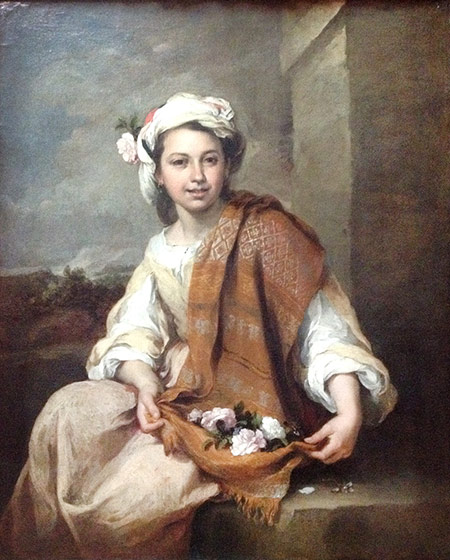The Flower Girl by Bartolomé Esteban Murillo (1665–70)

Murillo (1617–82) was an artist from Seville who became especially known for his genre scenes featuring children, often street urchins. This work, which belongs to the collection of the Dulwich Picture Gallery in London, is an excellent example of the type. A pretty young girl offers freshly-picked roses to passers by (and to the viewer too, whom she fixes with a smiling, forthright gaze). The palette of browns, ochres and dusty pinks is very typical of the artist. This seems an appropriate palette for the month of March, too, when the trees are bare of leaves and the soil is still brown, but dustings of blossom have appeared and the first flowers are bursting forth, offering a promise of spring. Some critics have seen this offer of promise as suggestive of the young flower-seller’s character: she has tucked one of the roses into her headcloth. The roses are for sale and so is she. This interpretation possibly traduces both the sitter and the artist. Murillo painted the work for his friend and patron Justino de Neve, a canon at Seville cathedral, and it has been suggested that the sitter was his own daughter, Francisca, who would have been between 10 and 15 years old when this was painted. In 1671 she renounced worldly things and became a nun, taking the name of Francisca María de Santa Rosa, after St Rose of Lima, who had been canonised that same year. The embroidered shawl that the flower-seller wears, interestingly, has been identified as of a Peruvian type, which would have come to Seville from Lima. Murillo’s influence on later painters of the 18th century is well known. In Britain he was greatly admired by Gainsborough, who, according to the forthcoming Blue Guide London (18th edition), ‘did not enjoy being, as he put it, a ‘phizmonger’ (portrait-painter). Perhaps as a reaction to this, out of his landscapes he developed his so-called ‘fancy pictures’, rustic genre paintings of peasant children and the deserving poor, which sought to evoke emotion and sympathy in the viewer. In this he was much influenced by Murillo.’
Blue Guide London (18th ed.), with extensive coverage of Dulwich Picture Gallery and its excellent collection, will be published this summer.






